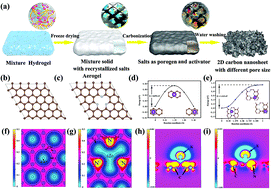Carbon defects applied to potassium-ion batteries: a density functional theory investigation†
Abstract
Functionalized carbon nanomaterials are potential candidates for use as anode materials in potassium-ion batteries (PIBs). The inevitable defect sites in the architectures significantly affect the physicochemical properties of the carbon nanomaterials, thus defect engineering has recently become a vital research area for carbon-based electrodes. However, one of the major issues holding back its further development is the lack of a complete understanding of the effects accounting for the potassium (K) storage of different carbon defects, which have remained elusive. Owing to pressing research demands, the construction strategies, adsorption difficulties, and structure–activity relationships of the carbon defect-involved reaction centers for the K adsorption are systematically summarized using first principles calculations. Carbon defects affect the ability to trap K by affecting the geometry, charge distribution, and conductive behavior of the carbon surface. The results show that carbon doping with pyridinic-N, pyrrolic-N, and P defect sites tend to act as trapping K sites because of electron-deficient sites. However, graphite-N and sulfur doping are less capable of trapping K. In addition, it has been proved using calculations that the defects can inhibit the growth of the K dendrite. Finally, using the molten salt method, we prepared the undoped and nitrogen-doped carbon materials for comparison, verifying the results of the calculation.



 Please wait while we load your content...
Please wait while we load your content...